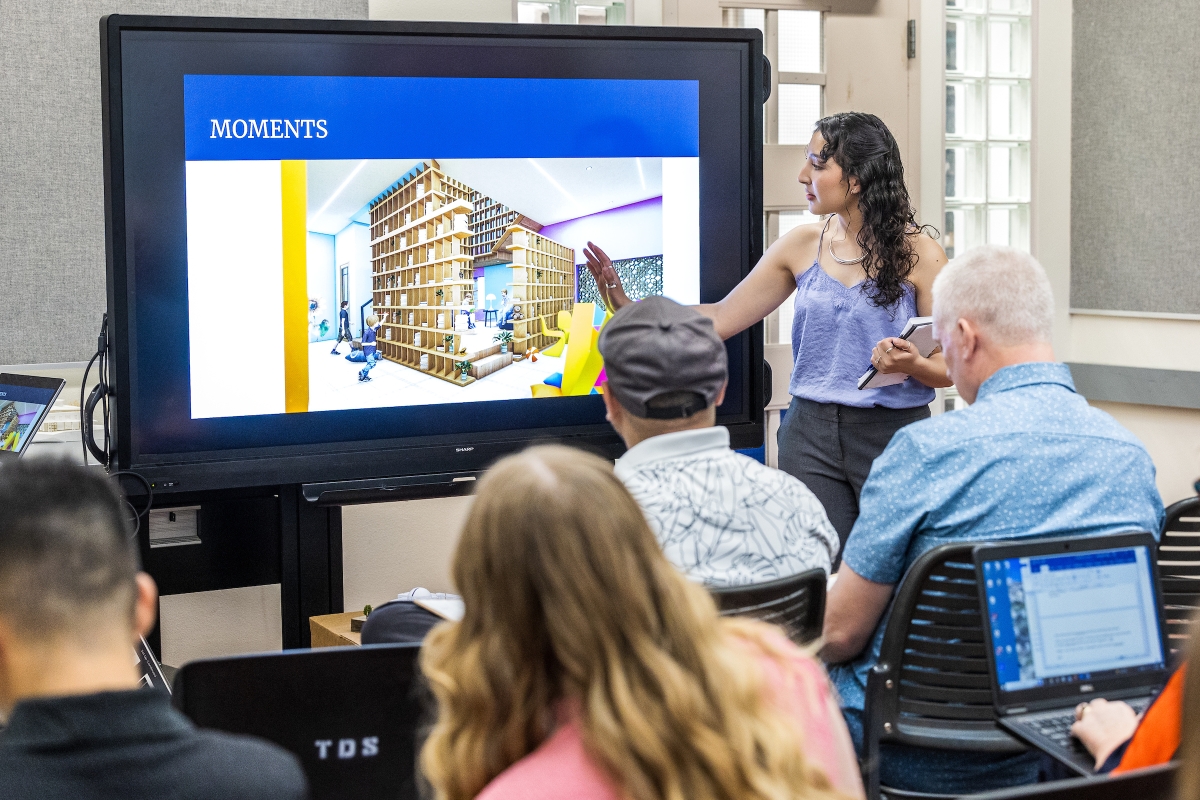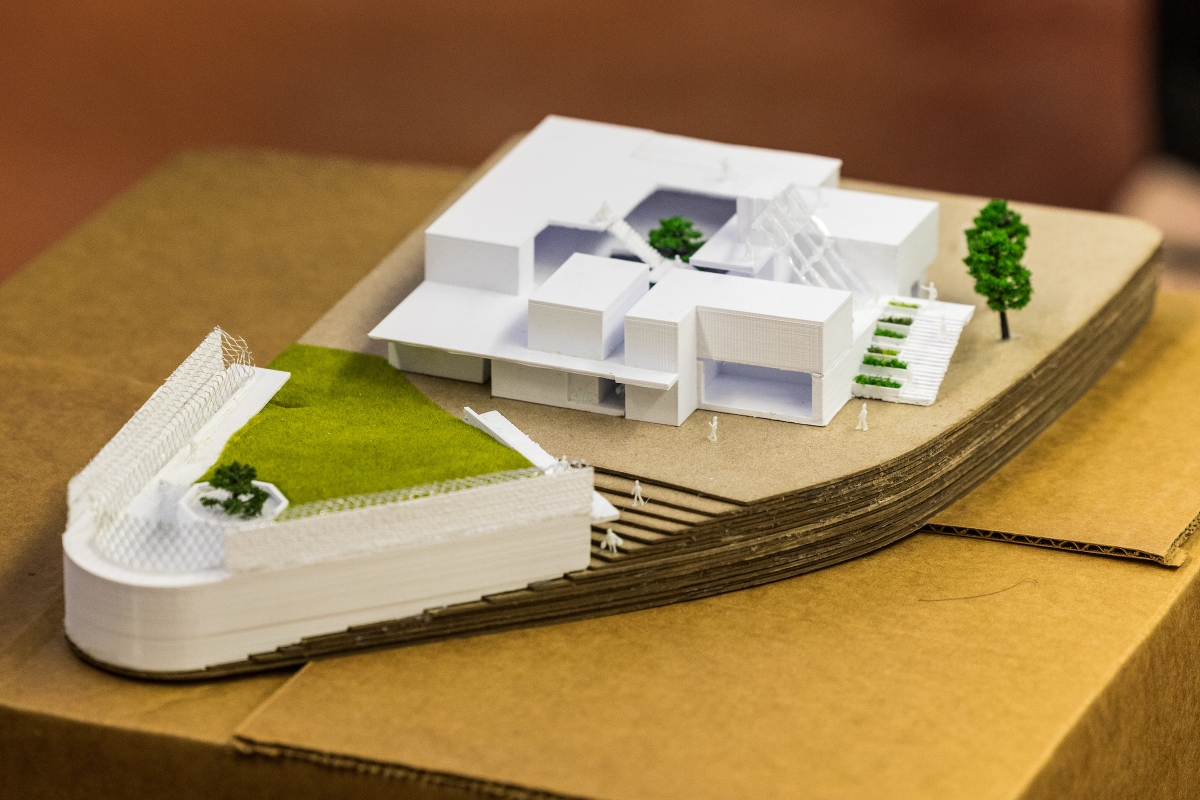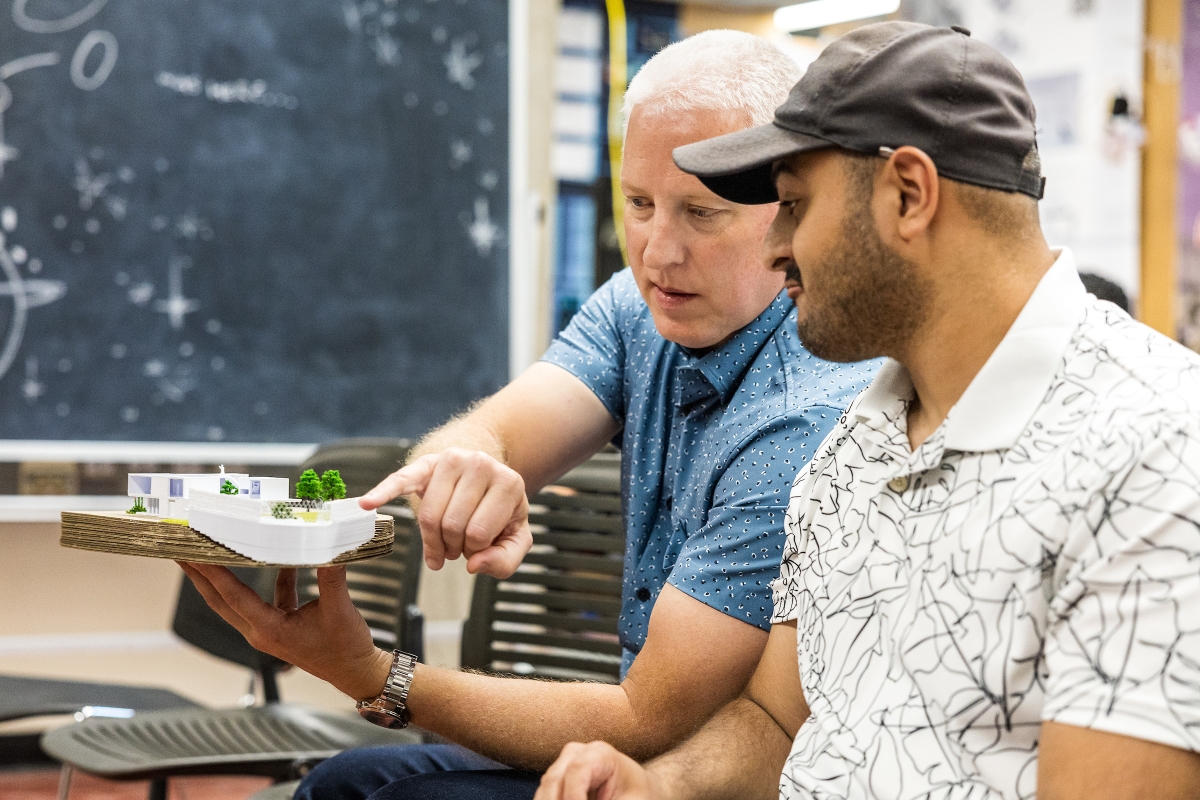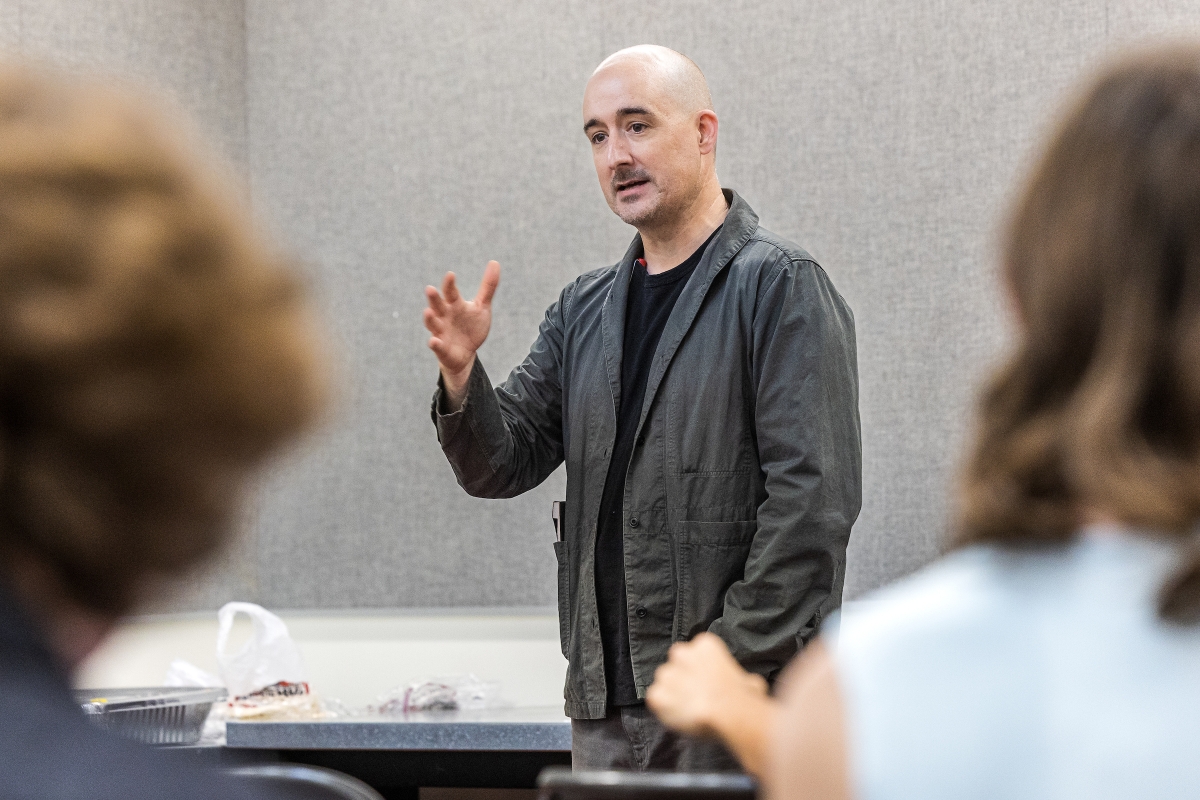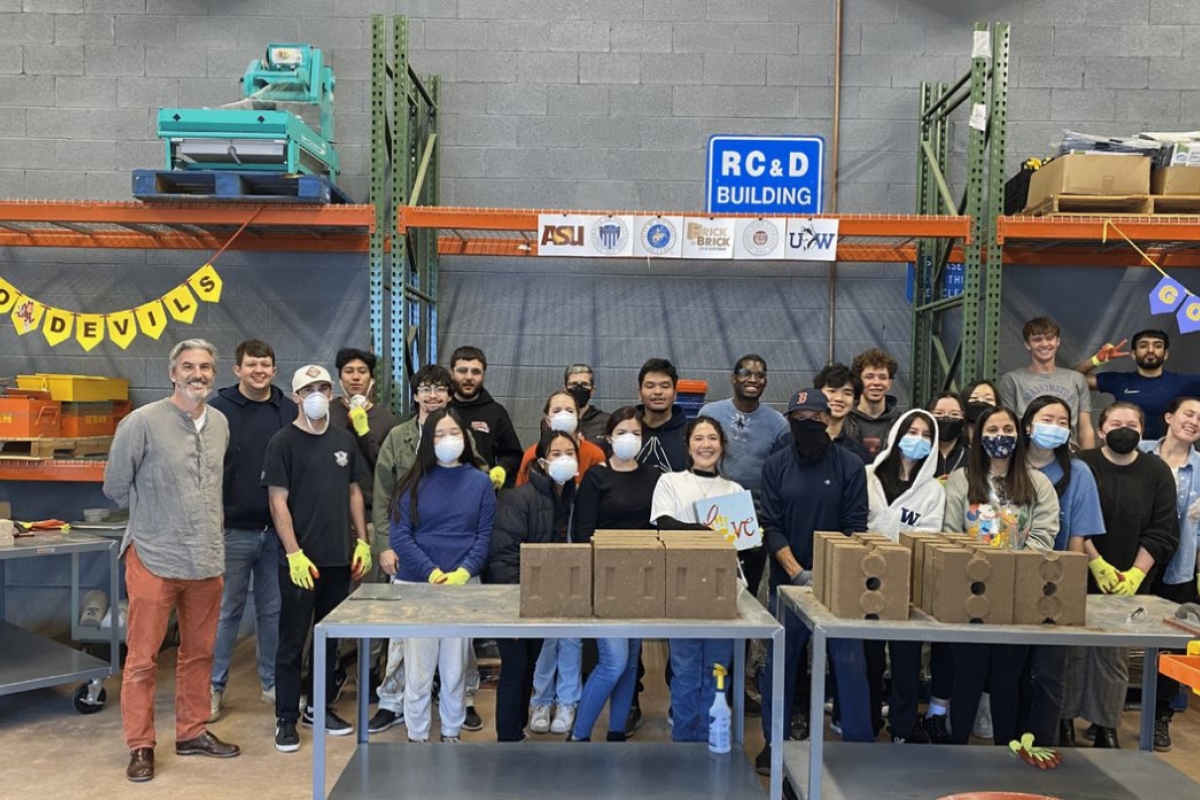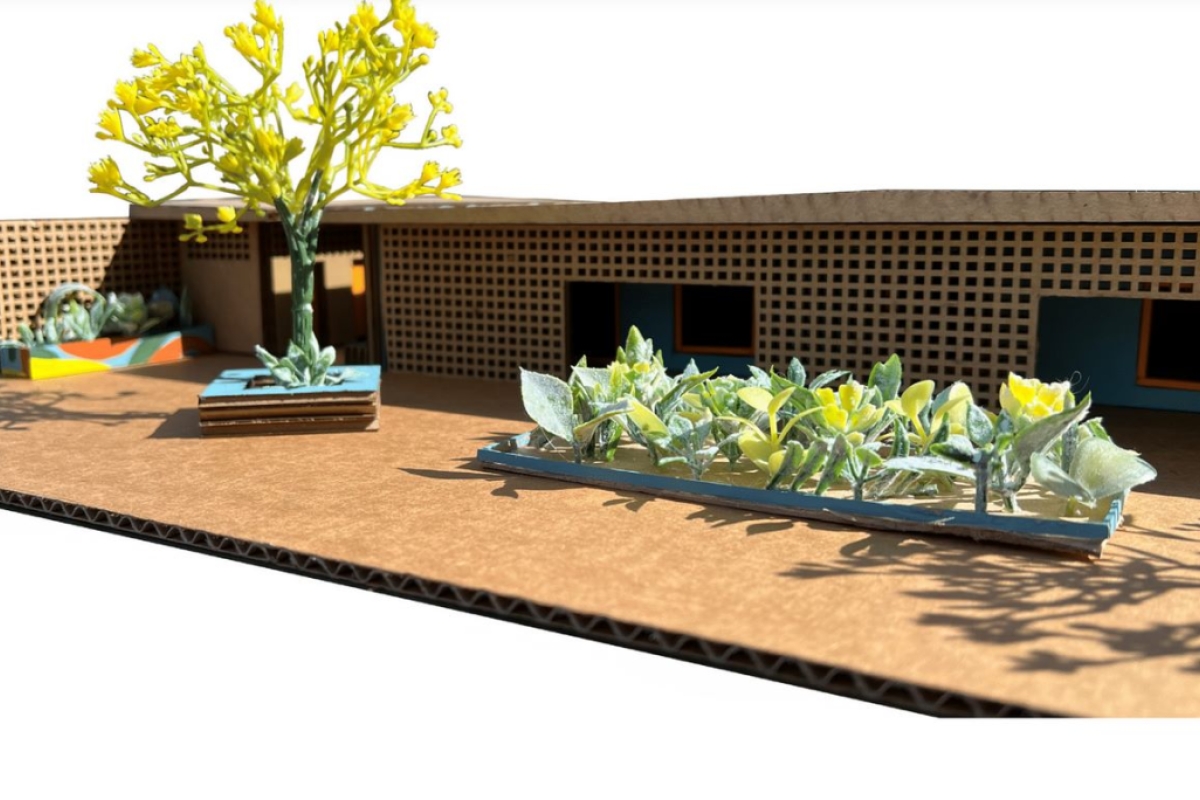ASU architecture students collaborate with Palestinian peers
Center of Building Innovation hosts cross-cultural Climate Futures Exchange
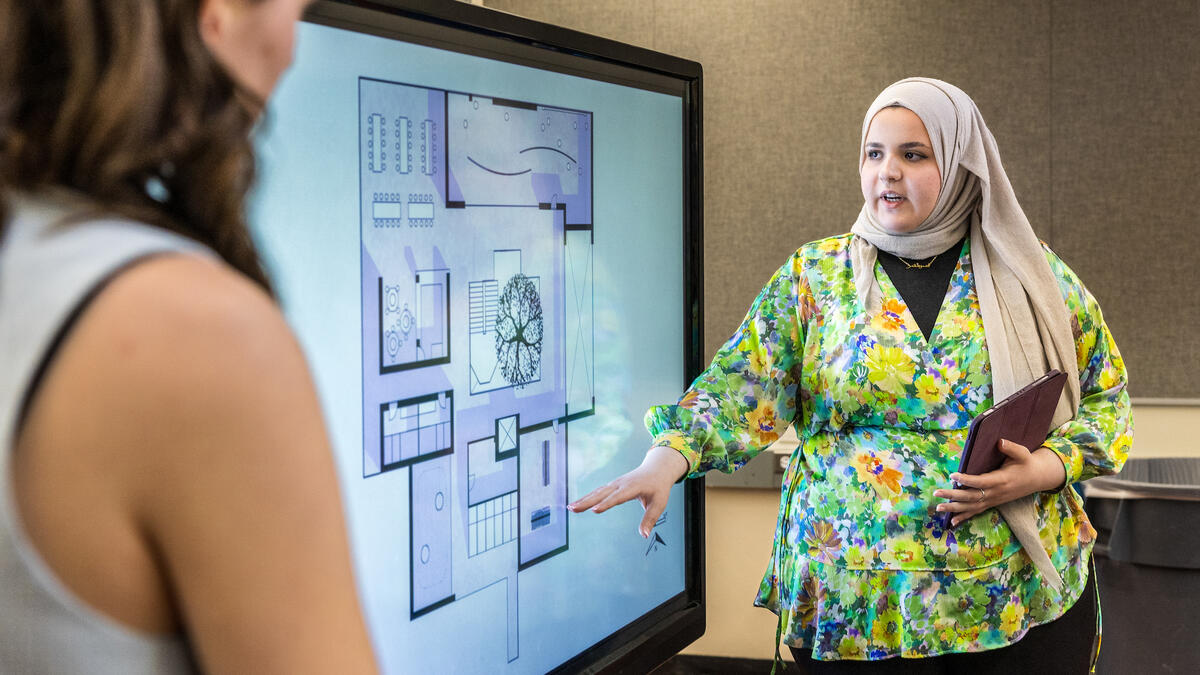
ASU architecture student Zahara Al Bahadli discusses her team's design in the final presentation of the Climate Futures Exchange studio in which ASU students collaborated with peers from An-Najah National University in Palestine. Photo by Charlie Leight/ASU News
A class of Arizona State University architecture students collaborated with peers from a Palestinian university this year on a project to reimagine a kindergarten building for children who are living amid conflict.
The Sun Devils came up with creative designs like a treehouse, “reading tents” and an alphabet wall as they learned about Palestinian culture from students at An-Najah National University. The two groups worked on a renovation for an existing kindergarten building in Nablus.
“The cultural exchanges were very touching and not only was it fun to learn from people across the world that otherwise I wouldn’t have contact with, I also enjoyed seeing how they worked,” said Uor Fawzi, an ASU student in the course.
The Climate Futures Exchange is a project of the Center of Building Innovation, an interdisciplinary center in The Design School at ASU. It’s funded for two years by a $300,000 grant from the J. Christopher Stevens Virtual Exchange Initiative, a U.S. Department of State’s Bureau of Educational and Cultural Affairs program administered by the Aspen Institute.
The exchange included a lecture course in the fall and the studio in the spring, both of which will be repeated next year. The funding paid for a graduate assistant, technology and related events, according to Phil Horton, a clinical associate professor of architecture and co-director of the Center of Building Innovation.
Horton had worked with faculty from An-Najah University on a studio project in 2017. In that year, the two groups of students collaborated on infrastructures such as community gardens and solar-shaded plazas for the Balata refugee camp in the West Bank.
Originally, this year’s project also was going to address the refugee camp. But on Oct. 7, the Hamas terrorist group attacked Israel, which led to ongoing counterattacks by Israel on sites in Gaza. Horton said the faculty decided to pursue a project that was more uplifting and found the kindergarten renovation plan via an alumna.
The goal was to create designs that encouraged learning through play.
To learn about the building — and the culture — the ASU and Palestinian students used Zoom and What’s App to communicate.
“One of the most important facets of design thinking is empathy — trying to understand the needs and desires of the folks who are going to be using the space that you're designing,” Horton said.
The students in both countries wrote a series of narratives imagining a day in the life of a kindergartner in Nablus — how they played and what they ate — as well as their own kindergarten experiences.
“We shared photos and report cards and work we did, and it was so cute seeing them,” said Fawzi, who graduated this month with a bachelor’s degree in architectural studies and will begin a master’s program in the fall.
“There are some things we had no idea that were prevalent in their kindergartens. They said that nap times are not a thing and they don’t have a cafeteria or scheduled time to eat lunch. They bring lunch and eat throughout the day or have snacks.
“So we didn’t include things like a nap room or a kitchen or a cafeteria,” she said.
The ASU students presented their designs at the end of the semester, and, to be sustainable, kept the shell of the building and focused on internal renovations. Their ideas included movable walls made of bookshelves, a rooftop playground and a multilevel tree in the courtyard.
The goal of the Center of Building Innovation is to address social and climate justice in the built environment. So the fall-semester lecture course, taught by Marc Neveu, a professor of architecture and the other co-director of the center, covered the drought in the West Bank and looked at technologies like rainwater capture and moisture harvesting from the air.
The studio course also looked at energy resilience. The kindergarten building is tied to grid energy even though most of Palestine’s power supply is controlled by other countries, including Israel.
So the ASU students incorporated ideas such as solar power, greywater recycling, photovoltaic glass and stationary bikes that generate power when the children pedal them.
The student team of William Kidd and Wendy Duong proposed an outdoor theater space and “play caves.”
“What we learned in the research is that play is a way that children express trauma, so the design is important for learning and play,” Kidd said.
Horton said the monthslong project allowed the students enough time to understand the family structures, cuisines and rituals of their counterparts.
“It worked incredibly well as a cultural exchange, which is what the Stevens Initiative Program really wants,” he said.
Because of the ongoing conflict, the Palestinian students have been learning remotely, and they overcame challenges such as shyness about appearing on camera and wavering confidence in speaking English.
“Having people they could talk to on the other side of the world when they were somewhat isolated has been really helpful,” Horton said.
“For our students to take interest in things like Eid, one of the holidays that occurred during the semester, and even just talk to one another about stressful moments helps to break down the stereotype that Americans don't care about Arab people or the challenges that exist for a typical Palestinian," he said.
The grant includes funding for some of the Palestinian students and faculty to visit ASU this fall, and the visa process for that is underway, Horton said.
The Climate Futures Exchange is just one project in the Center of Building Innovation. Last year, Neveu ran a studio in which students collaborated with the City of Scottsdale’s Brick by Brick program. In that program, people experiencing homelessness learn how to make compressed-earth bricks that are then used in city and commercial projects.
The ASU studio collaborated with a studio at the University of Washington, and the students worked with a Mesa pastor who houses refugees in his church building. A bus drops off the asylees several times a week.
“He feeds them, gives them a shower and they end up sleeping on the floor of his office or the classroom,” Neveu said.
“So he needed a shelter.”
The students created designs for a shelter made of the compressed-earth bricks, which are a traditional yet far more sustainable building material than current methods because they are energy efficient and are strong.
The studio was so successful that Neveu and Elizabeth Golden, the University of Washington professor, have won a grant to offer it again next January. That class will create new designs to incorporate the compressed-earth blocks as well as try to advance the refugee shelter project.
Like the Climate Futures Exchange, the Brick by Brick studio inspired empathy in the students for the vulnerable population they serve with their designs. At one session, a man showed the ASU team how to make the compressed-earth blocks. Afterward, the students realized the man was experiencing homelessness.
“He was doing the workshop to make some money and he would be sleeping on the streets that night,” Neveu said.
“It was a gut punch.”
More Environment and sustainability
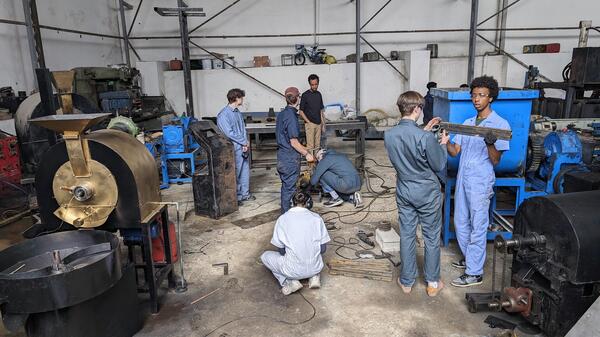
Student engineers travel to Ethiopia this summer to help protect local wildlife
The jagged peaks in Ethiopia’s Simien Mountains National Park are home to the rare gelada monkey. It is the only place in the entire world where the endangered animals — nicknamed the “bleeding-heart…

Global Futures Laboratory at ASU joins DOE initiative to empower women in clean energy
The U.S. Department of Energy-led Clean Energy Education and Empowerment Initiative has announced that Arizona State University now joins the initiative as a partnering university. The Julie…
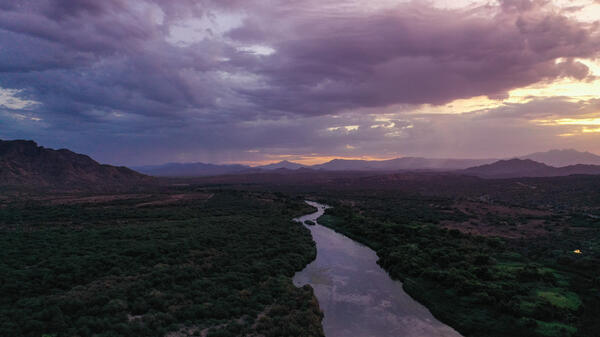
Computer modeling shows where Arizona's winter precipitation originates
The Sun Corridor in Arizona in the semi-arid Southwestern U.S. is a land of seemingly unlimited growth that is constantly colliding with physical constraints. It is mountainous but also home to a…
